“Will my breasts be flat if I get my implants removed?” This question comes up a lot, and the answer depends on a few different variables.
These factors include the size of your implants, the quality of your skin, and how your body heals itself naturally. Here at San Antonio Breast Implant Removal, we usually see a variety of results.
While some patients are pleased with the appearance of a flatter chest, other patients develop skin laxity or shape alterations. Knowing what will impact your outcome is key to establishing realistic expectations.
Will My Breasts Be Flat?
Breast appearance after implant removal very much depends on the individual and their situation. What most people are worried about is flatness or extreme transformation. Natural tissue, skin quality, and time since implant placement all contribute.
Initial Appearance
The first appearance immediately after surgery, breasts can appear flat or lumpy. This is totally normal and not how it will ultimately look.
Swelling will make your chest look larger or misshaped temporarily. In the coming weeks, swelling subsides and your tissues start to settle into place. The appearance will further improve over the next 6 to 9 months as the breast softens and settles into place.
Many have difficulty coping with body image changes undergone during this process. Understandably, it may take you a little while to process the new appearance.
Skin Elasticity
Skin elasticity is the most important factor in determining the appearance of the breast after implant removal. The younger you are, or the more good skin tone you have in general, the better rebound you’re going to have.
Age, genetics and previous pregnancies play a large role in skin recoil. If the skin was stretched a lot, it’s going to sag or wrinkle upon excision. Maintaining skin health before surgery such as hydration, no smoking, and limiting sun exposure, are beneficial.
Some even seek non-surgical treatments such as radiofrequency or laser therapy to enhance skin quality, with inconsistent results.
Native Tissue
As with any aesthetic procedure, the appearance of the breast largely relies on existing native tissue. If there is not much tissue available, flatness becomes more probable.
Others opt for a fat transfer to provide volume and achieve a more sculpted appearance. Since everyone’s tissue characteristics are different, outcomes will vary from person to person.
Implant Duration
Longer implant placement puts you at greater risk for stretched or thinned tissues. This can result in a more noticeable flatness.
The age of the implant also plays a role in the support of the skin and tissue. Women who have had implants for a long time will likely experience some additional sagging or loose skin after removal.
By keeping a close eye on one’s implants and breast tissue, it is possible to set realistic expectations.
Body Changes
Similar to prior to removal, weight changes may make reconstructed breasts appear fuller or flatter. Hormonal changes and age affect the tone of the tissue itself.

Factors Influencing Final Shape
The overall shape and appearance of the breasts after breast implant removal varies based on several factors. Every case is different. Each patient’s unique anatomy, implant history, and surgical plan influence the final outcome.
Implant Type
The type of implant that was used in the first place (saline vs silicone) has a huge impact on breast shape after removal. Saline implants deflate immediately upon removal, but silicone implants maintain their shape. This difference has a significant impact on the way your skin, tissue and muscle recover postoperatively.
Key ways implant type affects breast shape after removal:
- Saline: More likely to leave loose skin since they collapse rapidly.
- Silicone: May allow for a more gradual tissue adjustment.
- Larger implants: Stretch skin more, increasing the chance of sagging.
- Longer duration in place: More stretching, less natural retraction.
This decision may affect your options in the event that you ever want the implant removed.
Implant Placement
Subglandular implants (those placed above the muscle) put more tension on the breast tissue. This typically results in more apparent loose skin once it is removed. Submuscular placement takes place beneath the muscle, adding additional support from the chest muscle itself. This usually leads to a more subtle shape shift.
Implant placement affects more than just cosmetic appearance. Choices to come for any subsequent surgical procedures are important. In particular, those who had submuscular implants will have better tissue support if the patient requires a lift or some other procedure down the road.
Each person is going to have different outcomes depending on where they start out. Others develop more pronounced skin indentations or laxity, particularly if the implant was placed over the muscle.
Surgical Technique
Surgical technique plays a crucial role in the outcome. There is no single method that all surgeons follow for explant surgery. Special techniques like internal shaping or pairing removal with a breast lift have a very real impact on your final shape.
An experienced surgeon will be able to minimize post-operative scarring and asymmetry through careful selection of incision type and attention to tissue handling. Results can be different based on the path taken and your individual anatomy.
Healing Process
Healing is clearly an ongoing process. The bulk of the swelling and bruising disappears within one to three weeks.
Breast “fluffing”, also known as when the tissue settles and returns to a more organic appearance, can take three to six months or more.
Whether surgical or nonsurgical, most patients experience progressive improvement for 6 to 12 months as mature scars soften and fade.
Age Considerations
Patient age plays a role, as older patients will see more sagging from loss of skin elasticity.
Aging increases time to heal, and the reversibility of tissue retraction post-removal might be less effective.

Addressing Post-Removal Appearance
Breast shape after implant removal is influenced by your original tissue, skin elasticity, implant size, and how long the implants were in place. Most people are concerned with the first appearance, which is a somewhat flat or deflated appearance. That can be deceptive as the biological tissue heals and the swelling goes down.
Here are some suggestions to minimize post-removal appearance and improve explant success.
Options for improving breast appearance after explant:
- Skin tightening procedures: Can help with mild to moderate loose skin.
- Breast lift (mastopexy): Useful if sagging or drooping is present.
- Fat transfer: Adds volume using your own body fat.
- Aesthetic flat closure: For those who want a smooth, flat result.
- Scar management: Important for a better cosmetic outcome.
Each of the above options can be a topic of conversation with your surgeon to suit your specific goals and needs.
Natural Settling
Breasts typically appear more deflated or flat immediately post-op. This is completely typical. The surrounding tissue just needs time to settle in.
Over the first few weeks, swelling decreases, and the breast tissue starts to relax and expand, a process often called “fluffing.” You often don’t see your completed breast appearance for six to nine months. Some take less time to settle, and others can take over a year. Perhaps more than anything else, patience goes a long way.
Skin Tightening
Many patients seek out non-invasive skin tightening procedures, like radiofrequency or ultrasound-based treatments, to address sagging skin post-op.
If you have thinner skin, or skin that is less elastic, you will see more sagging. Getting adequate hydration and sun protection is important in the healing process as well. Refer all skin rejuvenation treatments to your surgeon prior to treatment.
Fat Transfer
Fat transfer means taking fat from another part of your body and transferring it to your breasts with the help of liposuction. This can bring back some of that lost volume and go a long way to create a more gentle, organic shape.
When done in conjunction with a lift, you’ll produce the most effective outcome. Recovery is fairly well tolerated, though there is some noticeable swelling and bruising.
Breast Lift
A breast lift may be the right choice for you if you are left with a lot of sagging skin following explant. It not only gets rid of the extra skin but reshapes the breast.
Occasionally, a lift is done in the same procedure as the removal of the implants. Set realistic expectations. While a lifted breast will have a smoother shape, it won’t give back all the implant volume lost.
Flat Closure
Flat closure is a possibility if you prefer a smooth, flat appearance. These results can be very attractive to patients who are looking to avoid additional surgical intervention or further volumetric increase.
Creating a flat closure can result in improved long-term maintenance. It’s crucial to consider all possible results and ensure that your surgeon is on the same page with your desired outcomes.
Making Sense of What to Expect After Implant Removal
Learning about how your chest may appear post-implant removal usually raises a lot more questions. What will my breasts look like after the implant removal?
Things such as your skin elasticity, how much tissue you have, and if you’ve had large implants for a long time are all factors. While some individuals find their breasts feel flatter or less full, others may not be able to perceive the difference.
It’s natural to feel unsure of yourself or even a little scared. Just like with implants, every person’s outcome is different and there is no cookie-cutter answer. For many, talking through options with a surgeon helps set realistic expectations and explore choices like a lift or fat transfer if needed.
If you have more questions about what to expect in your particular case, contact our team today! Even if you are still considering your options, a consultation is a perfect next step.






